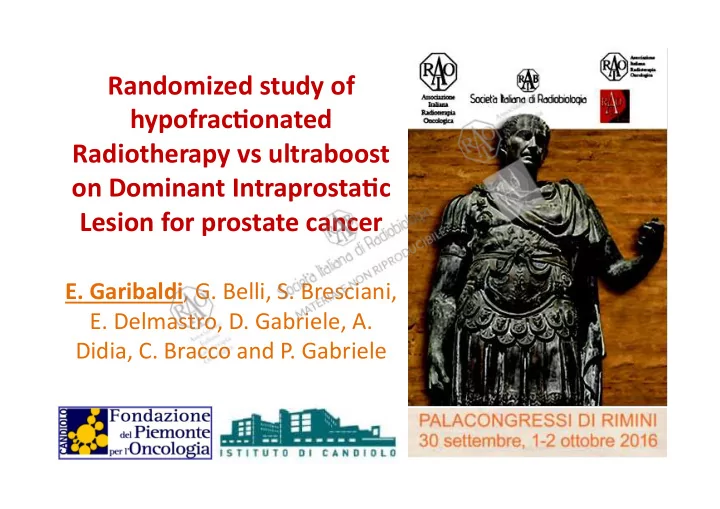

Randomized ¡study ¡of ¡ hypofrac4onated ¡ Radiotherapy ¡vs ¡ultraboost ¡ on ¡Dominant ¡Intraprosta4c ¡ Lesion ¡for ¡prostate ¡cancer ¡ E. ¡Garibaldi , ¡G. ¡Belli, ¡S. ¡Bresciani, ¡ E. ¡Delmastro, ¡D. ¡Gabriele, ¡A. ¡ Didia, ¡C. ¡Bracco ¡and ¡P. ¡Gabriele ¡ ¡
Background Tumor control probability is related to the RT dose Interna4onal ¡guidelines ¡agree ¡in ¡ recommending, ¡when ¡high ¡doses ¡are ¡ needed, ¡highly ¡conformal ¡technique ¡ (such ¡as ¡IMRT) ¡preferably ¡associated ¡with ¡ a ¡daily ¡check ¡of ¡the ¡treatment ¡(IGRT) ¡
Background Literature ¡data ¡confirm, ¡in ¡prostate ¡ cancer, ¡local ¡recurrence ¡usually ¡occur ¡in ¡ the ¡primary ¡tumor ¡(DIL), ¡rather ¡than ¡in ¡ focal ¡prostaCc ¡intraepitelial ¡neoplasia. ¡ SelecCve ¡irradiaCon ¡of ¡DIL ¡ by ¡dose ¡escalaCon ¡
Background The availability of functional imaging (multiparameter MRI/choline PET), can help the DIL localization “driving” of the volume contouring with greater precision for the radiotherapy treatment The Helical-IMRT technique (by Tomotherapy) allows to shape a very thrust conformational dose, contributing to a more precise deposition of the dose on the target tissues, limiting dramatically the exposure to normal tissues and finally reducing the risk of toxicity. Daily IGRT by MVCT, ensures the treatment precision.
Aim of DIL study Primary endpoints • Dosimetric and clinical feasibility of dose-escalation (in terms of acute and late toxicity) • Role of MRI in identifying DIL • Correlation between pre- treatment imaging parameters (position of DIL(s), volume, etc.) and toxicity. Secondary endpoints • Outcome (Biochemical control) • Correlation of outcome with quantitative analysis of MRI images
DIL-study design Intermediate and high risk prostate cancer patients with DIL(MRI) Prostate: 75.2Gy/32 fr (2,35/day) ( α / β =3 EQD2=80.5Gy) No-‑DIL ¡ SV: 67,2 Gy/32 fr (2,1/day) (ND) ¡ ( α / β =3 EQD2=68.5 Gy) + Pelvis: 54.4Gy/32 fr (1,7/day) ( α / β =3 EQD2=51.2 Gy) R ¡ Prostate: 75.2Gy/32 fr (2,35/day) ( α / β =3 EQD2=80.5Gy) DIL ¡ ¡ SV: 67,2 Gy/32 fr (2,1/day) (D) ¡ ( α / β =3 EQD2=68.5 Gy) + Pelvis: 54.4Gy/32 fr (1,7/day) ( α / β =3 EQD2=51.2 Gy) DIL: 83.2 Gy/32 fr ( α / β =3 EQD2 93.2 Gy) + ¡ADT ¡(neoadjuvant, ¡concomitant ¡and ¡adjuvant) ¡6 ¡mth/2y ¡ ¡
Inclusion criteria Histologically confirmed diagnosis Intermediate / high risk class , according to 2011-NCCN-guidelines (T2b-T2c-T3a N0M0 and / or Gleason score> 7, and / or PSA> 10 ng / ml Karnofsky Performance Status (KPS) = 90-100; Evidence of DIL, by multiparameter MRI Patient compliance to Tomotherapy Informed consent Exclusion criteria KPS < 90; previous TURP/HIFU Severe comorbidity : severe heart disease, patients with pacemakers, ulcerative colitis, Crohn's disease, decompensade diabetes, severe hypertension, severe obesity, psychiatric disorders > 2 DIL Ratio DIL volume/prostate gland volume > 20% Distance between DIL and rectum < 3 mm.
Material and methods March 2012 - May 2016: 38 patients enrolled All patients submitted to multiparameter MRI showing DIL(s) Pa4ent ¡characteris4cs ¡ D-‑arm ¡ ND-‑arm ¡ Pa4ent ¡n° ¡ 18 ¡ 20 ¡ Median ¡age ¡ 70 ¡(range ¡56-‑77) ¡ 71,8 ¡(range ¡67-‑80) ¡ Median ¡iPSA ¡(ng/ml) ¡ 7,05 ¡ ¡ 7,09 ¡ ¡ (range ¡4.12-‑18.5; ¡mean ¡ (range ¡3,7-‑15; ¡mean ¡7,4) ¡ 8.45) ¡ Gleason ¡Score ¡ Pa4ent ¡number ¡ Pa4ent ¡number ¡ 5 ¡ 1 ¡ 0 ¡ 6 ¡ 9 ¡ 10 ¡ 7 ¡ 8 ¡ 8 ¡ 8 ¡ 0 ¡ 1 ¡ ADT ¡ 13 ¡ 17 ¡
Material and methods All DIL contoured on MRI fusion (with Radiologist) Helical SIB-IMRT delivered using Tomotherapy Daily IGRT by integrated MV-CT. Acute and late toxicities were evaluated according to RTOG-EORTC scale. Outcome evaluated as biochemical control (according to Phoenix criteria).
Results Mean FU: 25 months (range 6-40) DIL irradiation NOT feasible in 3 patients (2 due to DIL volume/Prostate volume ratio > 20%; 1 due to rectum-DIL distance < 3mm) ACUTE ¡ G2 ¡ > ¡G3 ¡ TOXICITY ¡ Gastrointes4nal ¡ Genitourinary ¡ Gastrointes4nal ¡ ¡ Genitourinary ¡ D-‑arm ¡ 6% ¡ 12% ¡ 0% ¡ 0% ¡ ND-‑arm ¡ 5% ¡ 5% ¡ 0%% ¡ 5% ¡ At ¡last ¡FU ¡overall ¡bDFS ¡ LATE ¡ > ¡G2 ¡ TOXICITY ¡ was ¡100%. ¡Only ¡1 ¡ paCent ¡in ¡each ¡group ¡ Gastrointes4nal ¡ Genitourinary ¡ was ¡again ¡in ¡ADT. ¡ D-‑arm ¡ 0% ¡ 0% ¡ ND-‑arm ¡ 0% ¡ 0% ¡ Updated September 2016
Conclusion Our ¡results ¡show ¡ultraboost ¡on ¡the ¡DIL, ¡up ¡to ¡an ¡EQD2 ¡ of ¡93,2 ¡Gy, ¡is ¡feasible ¡and ¡safe ¡by ¡Tomotherapy, ¡ without ¡increasing ¡acute ¡or ¡late ¡toxiciCes. ¡However, ¡in ¡ order ¡to ¡assess ¡late ¡toxicity ¡and ¡biochemical ¡response, ¡ a ¡longer ¡follow-‑up ¡is ¡needed. ¡
Recommend
More recommend